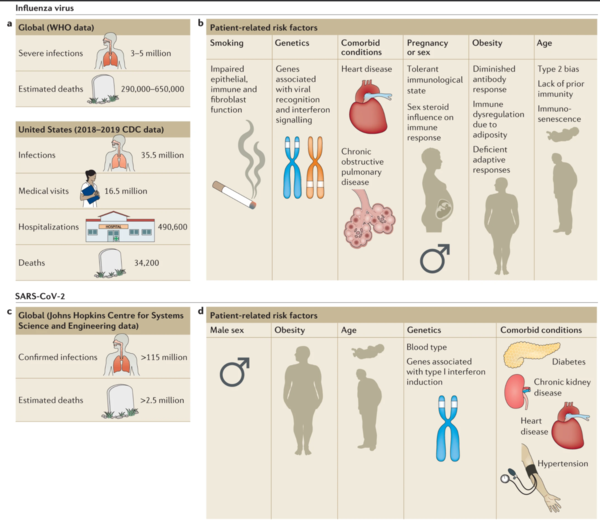Influenza viruses cause annual epidemics and occasional pandemics of respiratory tract infections that produce a wide spectrum of clinical disease severity in humans. The novel betacoronavirus severe acute respiratory syndrome coronavirus 2 (SARS-CoV-2) emerged in December 2019 and has since caused a pandemic. Both viral and host factors determine the extent and severity of virus-induced lung damage. The host's response to viral infection is necessary for viral clearance but may be deleterious and contribute to severe disease phenotypes. Similarly, tissue repair mechanisms are required for recovery from infection across the spectrum of disease severity; however, dysregulated repair responses may lead to chronic lung dysfunction. Understanding of the mechanisms of immunopathology and tissue repair following viral lower respiratory tract infection may broaden treatment options. In this Review, we discuss the pathogenesis, the contribution of the host response to severe clinical phenotypes and highlight early and late epithelial repair mechanisms following influenza virus infection, each of which has been well characterized. Although we are still learning about SARS-CoV-2 and its disease manifestations in humans, throughout the Review we discuss what is known about SARS-CoV-2 in the context of this broad knowledge of influenza virus, highlighting the similarities and differences between the respiratory viruses.
インフルエンザウイルスは、毎年のように流行し、時にはパンデミックを引き起こす呼吸器感染症であり、ヒトでは様々な重症度の臨床的疾患を引き起こす。2019年12月に新型ベータコロナウイルス重症急性呼吸器症候群コロナウイルス2(SARS-CoV-2)が出現し、その後パンデミックを引き起こしている。ウイルスと宿主の両方の要因が、ウイルスによる肺障害の程度と重症度を決定する。ウイルス感染に対する宿主の反応は、ウイルスのクリアランスに必要であるが、劇症化し重篤な疾患表現型の原因となる可能性がある。同様に、組織の修復機構は、疾患の重症度にかかわらず、感染からの回復に必要であるが、修復反応の調節がうまくいかないと、慢性的な肺機能障害を引き起こす可能性がある。ウイルス性下気道感染後の免疫病理と組織修復のメカニズムを理解することは、治療の選択肢を広げる可能性がある。この総説では、インフルエンザウイルス感染症の発症メカニズム、重篤な臨床症状に対する宿主反応の寄与、そして、これまでよく知られていたインフルエンザウイルス感染症の初期および後期の上皮修復メカニズムを紹介する。SARS-CoV-2とそのヒトでの症状についてはまだ解明されていないが、この総説では、SARS-CoV-2についてわかっていることを、インフルエンザウイルスに関する広範な知識と照らし合わせて説明し、呼吸器系ウイルスの類似点と相違点を強調している。
Fig. 1: Patient-related risk factors for severe influenza virus and SARS-CoV-2 infections.

https://www.nature.com/articles/s41579-021-00542-7